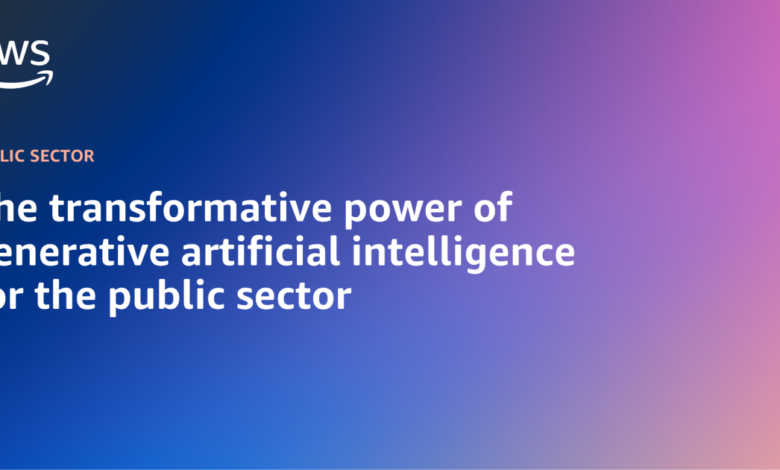The transformative power of generative artificial intelligence for the public sector

Generative artificial intelligence (AI) has recently captured widespread attention, and for good reason. This emerging technology has the potential to transform customer experiences, create novel applications, help people reach new levels of productivity, and much more. In fact, according to research from Goldman Sachs, generative AI could drive a 7 percent—or almost $7 trillion—increase in global GDP and lift worker productivity by 1.5 percentage points over a 10-year period.
Applications and user experiences are poised to be reinvented with generative AI, and the public sector is no exception. Governments, education institutions, nonprofits, and health systems must constantly adapt and innovate to meet the changing needs of their constituents, students, beneficiaries, and patients. If used responsibly, this powerful technology can open doors to endless possibilities to increase creativity, productivity, and progress. Amazon Web Services (AWS) is striving to make it possible for developers of all skill levels and for organizations of all sizes to innovate using generative AI.
The power of AI on AWS
New, simple-to-use generative AI tools such as Amazon Bedrock and Amazon SageMaker are democratizing the use of generative AI, making it accessible to anyone. Amazon Bedrock provides organizations the flexibility to choose from a wide range of foundation models (FMs), including open source and proprietary models built by leading AI startups, as well as Amazon, to identify the appropriate base model and build differentiated applications using their own data. The customer controls how their data is shared and used while remaining protected, secure, and private during the process. None of the customer’s data is used to train the original base models, and since all data is encrypted and does not leave a customer’s virtual private cloud (VPC), customers can trust that their data will remain private and confidential. Amazon SageMaker helps complete each step of the data preparation workflow, including data selection, cleansing, exploration, bias detection, and visualization from a single visual interface in minutes to easily deploy and customize FMs.
Responsible AI is an integral part of the entire AI lifecycle at AWS including design and development, deployment, and ongoing use. The relevance of responsible AI will only grow and that is why we have dedicated AWS experts wholly committed to stay on the cutting-edge of research, provide best practices, and develop rigorous methodology to build our AWS AI and machine learning (ML) services in a responsible way. We help customers transform responsible AI from theory into practice—by giving them the tools, guidance, and resources they need to get started with purpose-built services and features, such as Amazon SageMaker Clarify, Amazon SageMaker Model Monitor, and ML Governance from Amazon SageMaker.
To continue supporting best practices in the responsible use of AI, Amazon Titan FMs available within Amazon Bedrock are built to detect and remove harmful content in the data, reject inappropriate content in the user input, and filter the models’ outputs that contain inappropriate content (such as hate speech, profanity, and violence). Additionally, with Amazon Bedrock’s serverless experience, customers can get started quickly without having to manage any infrastructure. Whatever task customers are trying to accomplish with FMs—running them, building them, customizing them—they need the highest-performing, most cost-effective infrastructure that is purpose-built for ML: the AWS Cloud.
AI in the public sector
In today’s digital world, citizens expect the same world-class technology experience from government that they expect when they log in to their favorite streaming service or shop online. Generative AI is helping organizations to meet these expectations by tailoring services to individual citizens’ needs across a breadth of platforms.
Large language models (LLMs) and FMs can process and analyze vast amounts of data, oftentimes much faster and more efficiently than a human could. AWS supports government, education, nonprofit, aerospace and satellite, and healthcare organizations using generative AI to help query and analyze large amounts of information—such as public health data, economic indicators, and crime statistics—to identify patterns, trends, and correlations. This kind of analysis provides organizations with a comprehensive view of a particular topic, which in turn allows them to be more proactive in carrying out their mission. For example, the AWS Cloud Innovation Center (CIC) at California Polytechnic State University enabled students and staff to build a secure, cloud-based tool that makes cybersecurity recommendations for public sector organizations. Working with the San Diego Cyber Center of Excellence and Regional Cyber Lab, the My eCISO generative AI-enabled chatbot was developed to provide cybersecurity recommendations after a user answers a series of open-ended questions. Inputs and chat responses are securely stored and accessible to only those who have been granted access.
Generative AI is transforming how researchers work, helping them find information faster and freeing them up to pursue new experimental designs. It is helping researchers accelerate their work by creating highly complex levels of analysis that would traditionally take days, months, or even years. UK Biobank, for example, is a large-scale biomedical database and research resource, containing in-depth genetic and health information from 500,000 UK participants. It currently holds 17 million samples totaling 32 petabytes of data. Thousands of new samples are added daily as well as new datasets, such as whole genome sequencing, and UK Biobank is looking toward generative AI and cloud-based tools to help in analyzing the vast quantities of different types of data. The database is regularly augmented with additional data and is globally accessible to approved researchers undertaking vital research into the most common and life-threatening diseases.
The future of AI
According to an AWS funded study, AI is already transforming the workplace—from how businesses operate to how work gets done. What’s more, the pace of change is startling, with more than 90 percent of surveyed employers predicting that they will use AI-related solutions in their organizations by 2028. Generative AI simplifies routine tasks, allowing humans to concentrate on more important mission goals. Automating some processes and decreasing reliance on manual labor not only frees up human effort for crucial undertakings but also results in substantial cost savings over time.
While still in the early days, we believe that generative AI will greatly impact how public sector organizations operate, implement, and manage services and serve citizens and end users. As public sector organizations develop solutions powered by generative AI, it is important we understand how we should build responsible AI products and services. It’s crucial to adopt a people-centric perspective, which goes beyond just technology and incorporates people, processes, and culture. AWS is integrating responsible AI throughout the development cycle for our engineering and development teams. We equip our customers with the necessary resources, guidance, and tools to convert responsible AI concepts into actual practices. We continuously innovate and refine our responsible AI strategy to enhance and broaden our knowledge of the field as generative AI evolves. Although it’s challenging work, we’re constantly learning and growing in the realm of responsible AI.
I encourage you to gain a better understanding of generative AI and how public sector organizations are using these technologies. A couple of ways you can do this is by taking a masterclass on the best uses of AI for governments and checking out this Get started with generative AI on AWS eBook specifically for public sector.



